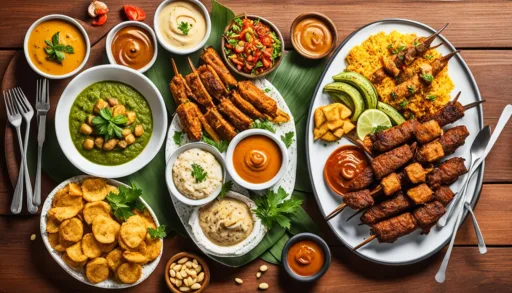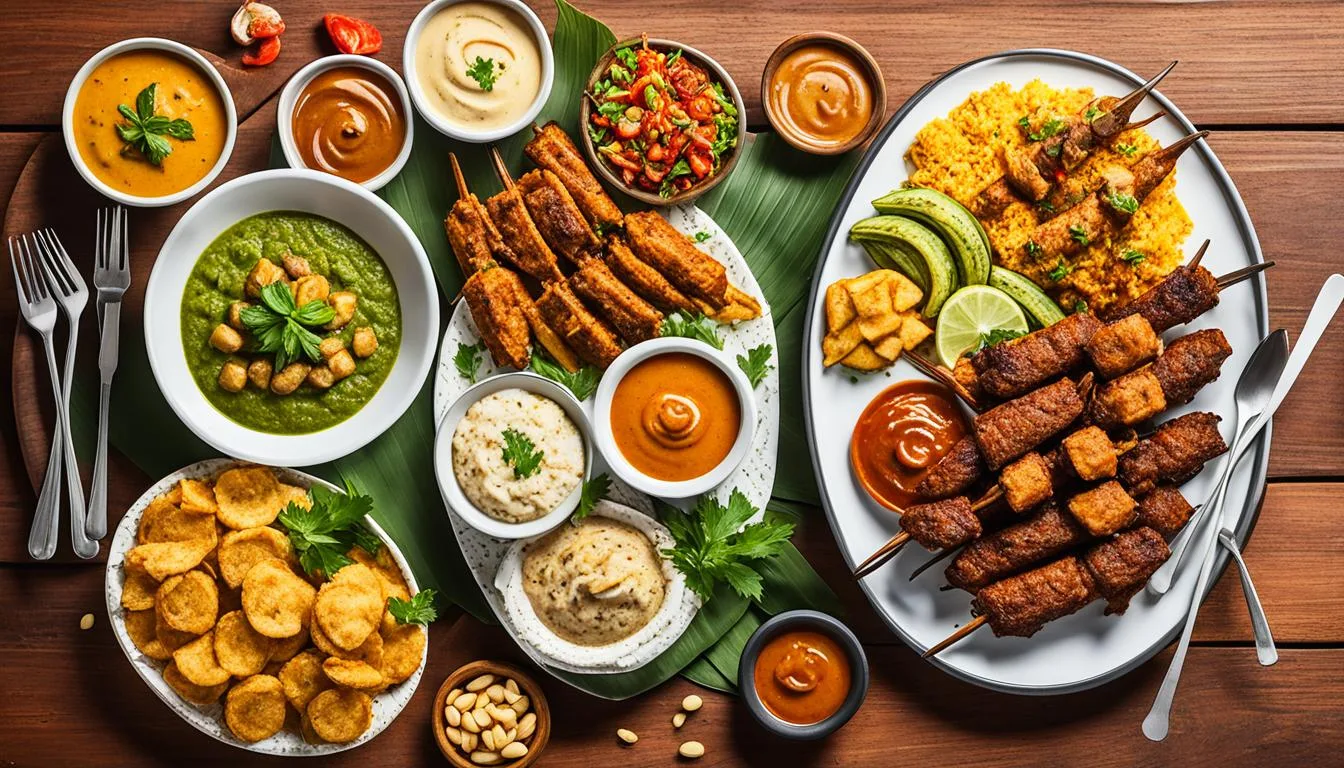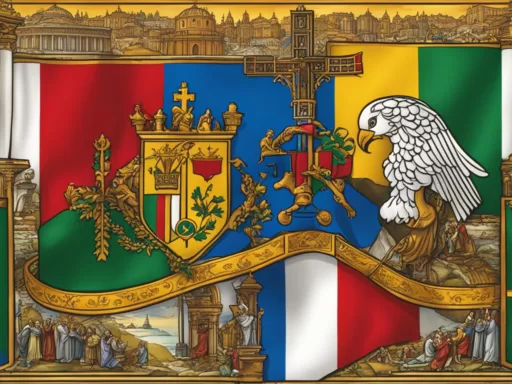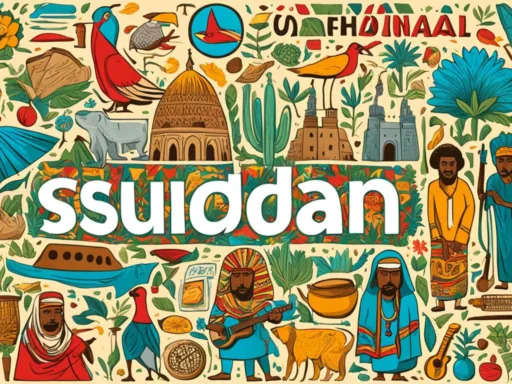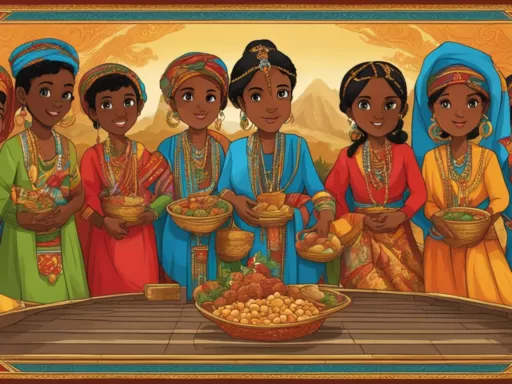Did you know that in Ghana, a country with more than 30 million people, each ethnic group has its distinct traditional dish contributing to a diverse culinary landscape? This unexpected fact is a testament to the rich food culture of Ghana, making it a haven for food enthusiasts eager to explore a tapestry of tastes. Through this Ghanaian culinary guide, we offer a window into a world where traditional Ghanaian dishes are more than just food; they are storied expressions of a nation’s soul.
Key Takeaways:
- Discovering Ghana’s culinary diversity reveals the country’s cultural wealth.
- Traditional Ghanaian dishes serve as a reflection of the nation’s history and ethnic diversity.
- Ingredients found in Ghanaian cuisine often have deep historical roots and cultural significance.
- Markets and street food stalls are perfect venues for an authentic taste of Ghana’s rich food culture.
- Ghanaian cuisine is renowned for its complex flavors, blending savory, spicy, and sweet.
- Exploring Ghanaian flavors offers insight into the nation’s traditional food practices and innovations.
The Unique Blend of Flavors Defining Ghanaian Cuisine
Delving into the myriad tastes that represent Ghanaian cuisine offers a palate-pleasing journey through a legacy rich in diversity and agricultural bounty. The collaboration of local cooking methods and an in-depth understanding of regional ingredients stands as the cornerstone of the celebrated Ghanaian food culture.
Impact of History and Culture on Ghanaian Culinary Practices
The tapestry of Ghanaian recipes has been intricately woven by its historical narrative, with influences stemming from both indigenous practices and foreign trade. Each ethnic community within Ghana takes pride in contributing distinct flavors and methods that spotlight the multicultural character of the region. This fusion of cultures has given rise to a food culture that tells a storied past through every dish.
Traditional Cooking Techniques and Their Significance
Authentic Ghanaian cooking techniques have been passed down through generations as a testament to the nation’s loyalty to its roots. The staples of cooking on open fires and using clay pots are not just practices; they serve as the contributors to the unique charred and earthy flavors synonymous with Ghanaian dishes. This homage to tradition maintains the genuine taste that is paramount to the nation’s culinary identity.
The Role of Local Ingredients in Authentic Ghanaian Recipes
The fertile lands of Ghana bear a wealth of produce, from which locals draw inspiration to invent and sustain a variety of delectable meals. The role of local ingredients is imperative in the realm of Ghanaian recipes, offering a kaleidoscope of flavors that is intrinsically linked to the nation’s varying landscapes. Ingredients such as cassava and plantains are not merely additions; they are essential components that reflect the spirit and essence of true Ghanaian cuisine.
| Ingredient | Location | Use in Cuisine |
|---|---|---|
| Cassava | Throughout Ghana | Base for dishes like Fufu |
| Plantains | Coastal regions | Fried for Kelewele or boiled as an accompaniment |
| Rice | Northern regions | Primary ingredient in Waakye and Jollof |
Embracing the bountiful array of produce, from the dense forests to the bustling coastlines, Ghanaian chefs and home cooks alike honor the geographic diversity present in their culinary creations. This deep respect for the local palate ensures that every meal is an authentic embodiment of Ghana’s rich and vibrant food culture.
Ghanaian Culinary Guide: A Taste of Tradition and Innovation
The heart of Ghana’s rich culinary heritage beats with a rhythm of tradition intertwined with innovative twists. As we explore the essence of traditional Ghanaian cooking, we find ourselves captivated by the rich palette of popular Ghanaian spices that elevate the flavor profiles of the best Ghanaian meals. This fusion of the old and the new is not only a testament to Ghanaian culinary resilience but an invitation to savor a tapestry of tastes that has been lovingly woven over time.
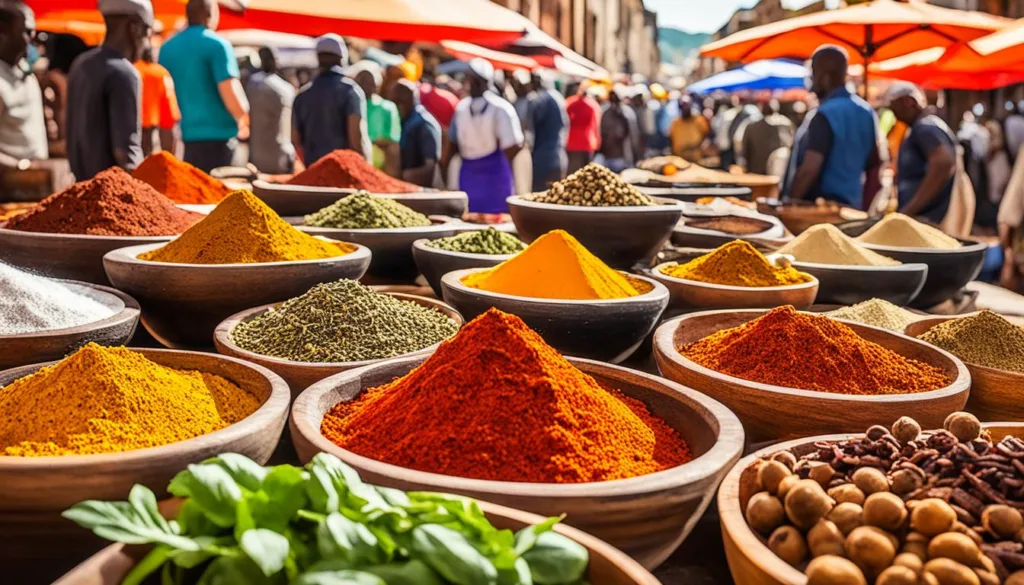
Within the bustling markets and cozy kitchens of Ghana, chefs continue to honor the age-old practices passed down through generations while also embracing the global influences that contribute to the nation’s delectable dishes. From the spicy wafts of Kelewele to the comforting embrace of a well-prepared Fufu, the adaptability and creativity of Ghana’s food artisans are key ingredients in the country’s culinary evolution.
By maintaining the core of what makes Ghanaian cuisine uniquely tantalizing, these culinary artists manage to encapsulate the soul of Ghana in every dish they create.
Below are some quintessential Ghanaian flavors and dishes that embody the confluence of tradition and innovation:
| Spice/Ingredient | Role in Traditional Cooking | Contemporary Twist |
|---|---|---|
| Grains of Selim | Earthy tones in stews and soups | Infusing cocktails and modern sauces |
| Scotch Bonnet Pepper | Heat element in most dishes | Used in spicy chocolates and jams |
| Prekese | Aromatic soups | Health drinks boasting medicinal benefits |
| Palm Nut Oil | Rich stews and sauces | Vegetarian dishes as a flavor enhancer |
- Jollof Rice – A contested masterpiece, constantly being reinvented across borders.
- Banku and Grilled Tilapia – A classic combination, receiving modern garnishes and presentations.
- Waakye – Traditional breakfast dish now becoming a gourmet offering in fine dining experiences.
What remains unperturbed through the waves of change is the Ghanaians’ love for their food — a love that transcends time and trends. As you partake in the sumptuous feast that is Ghanaian cuisine, remember that each bite is a story of tradition and innovation, marinated in history, and served with a side of continuous transformation.
Must-Try Dishes from the Heart of Ghana
Exploring the heart of Ghana’s gastronomy is a journey through a rich mosaic of flavors and time-tested culinary practices. In the vibrant tapestry of Ghanaian culinary traditions, certain dishes stand out for their ability to capture the essence of traditional flavors, each offering an authentic gustatory experience. Let us delve into the realm of traditional Ghanaian dishes that are a must-try for any epicurean enthusiast looking to savor the true taste of this nation’s flavorful Ghanaian cuisine.
Savoring the Beloved Jollof Rice
A visit to Ghana is incomplete without indulging in the beloved Jollof Rice. The dish, known for its sumptuous blend of tomatoes, onions, long-grain rice, and an array of spices, is a staple that commands the respect of a full culinary parade. This iconic meal embodies regional variations, each narrating a different story of the area it represents, and has become a vibrant symbol of Ghana’s shared culinary identity.
Banku and Tilapia: A Tasteful Duo
The combination of Banku and Tilapia is more than a meal; it’s a gastronomic celebration of Ghana’s natural resources. Banku, a smooth, fermented dough, is perfectly complemented by the fresh flavors of Tilapia, a testament to the country’s freshwater treasures. Often served with zesty sauces, this duo is a testament to the artful pairing that Ghanaian cuisine so effortlessly achieves.
Waakye: An Experience Beyond Just Food
No exploration of Ghanaian cuisine is complete without sampling Waakye. Originating from the Northern regions, this dish transcends its humble roots to become a nationwide favorite. The delightful medley of rice and beans, spiced to perfection and accompanied by an array of side dishes, is not merely a meal but a communal culinary experience that unites people and palates.
As you journey through Ghana, whether in bustling city eateries or at a local food stall, these representative dishes invite you to partake in an experience deeply rooted in cultural tradition, offering a window into the soul of Ghana and its warm, welcoming spirit. They are, without a doubt, much more than mere sustenance; they are time-honored emblems of Ghana’s rich and flavorful heritage.
Exploring the Storied Origins of Ghanaian Dishes
The rich tapestry of authentic Ghanaian cuisine is woven through its storied past, where every meal tells a tale of culture, tradition, and communal heritage. Delving into this past reveals the historical roots and significance of some of Ghana’s signature dishes—journeys that are not only geographical but are deeply entrenched in the nation’s soul.
From Senegal to Ghana: The Journey of Jollof Rice
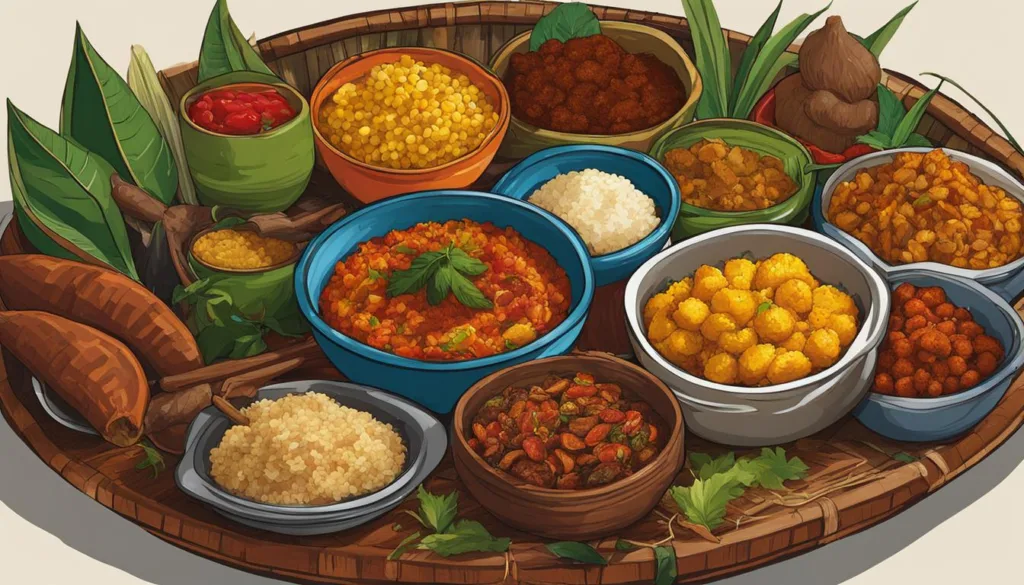 The beloved Jollof Rice, a vibrant and aromatic dish, has crossed borders and become an intrinsic part of Ghanaian cultural heritage. Its odyssey from Senegal and Gambia to the Ghanaian dinner table illustrates a story of shared West African flavors and the subtle nuances that make every region’s version unique.
The beloved Jollof Rice, a vibrant and aromatic dish, has crossed borders and become an intrinsic part of Ghanaian cultural heritage. Its odyssey from Senegal and Gambia to the Ghanaian dinner table illustrates a story of shared West African flavors and the subtle nuances that make every region’s version unique.
Fufu: A Symbol of Akan Culinary Heritage
Fufu, a delight in Ghanaian households, represents the innovation in traditional Ghanaian cooking. The diversity in its preparation, using ingredients like cassava and plantains, celebrates the culinary heritage of the Akan people and their contribution to Ghana’s flavorful array of staples.
The Cultural Tapestry Weaved by Tuo Zaafi
In Northern Ghana, Tuo Zaafi stands as more than a meal—it’s a culinary embodiment of the region’s agrarian lifestyle. This dish has harmonized the use of native grains and herbs to create a meal that’s both nutritious and steeped in communal reverence, highlighting the cross-cultural influences that have enriched Ghanaian cuisine.
- Each dish’s origin story enriches the collective narrative of Ghana’s diverse cuisine.
- Classic recipes are revered, not only for flavor but for their cultural symbolism.
- The evolution of these dishes is a testament to the adaptable nature of Ghanaian cooking.
As we relish these dishes, we engage in an ongoing dialogue with Ghana’s history—a feast for the palette as much as it is a celebration of identity and the enduring spirit of its people. The tales behind these dishes remind us of the inseparable bond between food and cultural expression.
The Staple Ingredients of Ghanaian Cuisine
Ghanaian ingredients are renowned for their ability to transform simple meals into complex flavor profiles, distinguishing the versatile Ghanaian cuisine. The key Ghanaian spices, alongside several primary ingredients, lay the groundwork for an authentic cooking experience that is both uniquely Ghanaian and inviting to food enthusiasts around the world.
Uncovering the Versatility of Plantains in Ghanaian Dishes
The many faces of plantains within Ghana’s culinary landscape highlight the adaptability of this ingredient. From the spicy, delight of Kelewele to their use in creating the foundation for traditional fufu, plantains boast a versatility that is integral to Ghanaian gastronomy.
Groundnuts: The Backbone of Many Ghanaian Recipes
Groundnuts, or peanuts, are not just a popular snack but a core element in a myriad of Ghanaian dishes. Their rich flavor infuses into stews and soups, such as the cherished Nkatenkwan, offering a creamy, nutty dimension that is beloved in the region.
Palm Nut Oil and Its Integral Role in Authentic Cooking
With its distinct red hue and robust flavor, palm nut oil is a staple in many kitchens across Ghana. The oil adds more than just vibrance to a dish; it is a key carrier of flavor and an essential component in a variety of traditional dishes.
| Ingredient | Role in Ghanaian Cuisine | Typical Dishes |
|---|---|---|
| Plantains | Used both in savory and sweet forms, fried or boiled | Kelewele, Fufu, Banku |
| Groundnuts | Provide a nutty base in stews and soups | Nkatenkwan (Peanut Soup), Groundnut Paste |
| Palm Nut Oil | Offers distinctive color and flavor, used in marinades and sauces | Palm Nut Soup, Abenkwan (Palm Soup) |
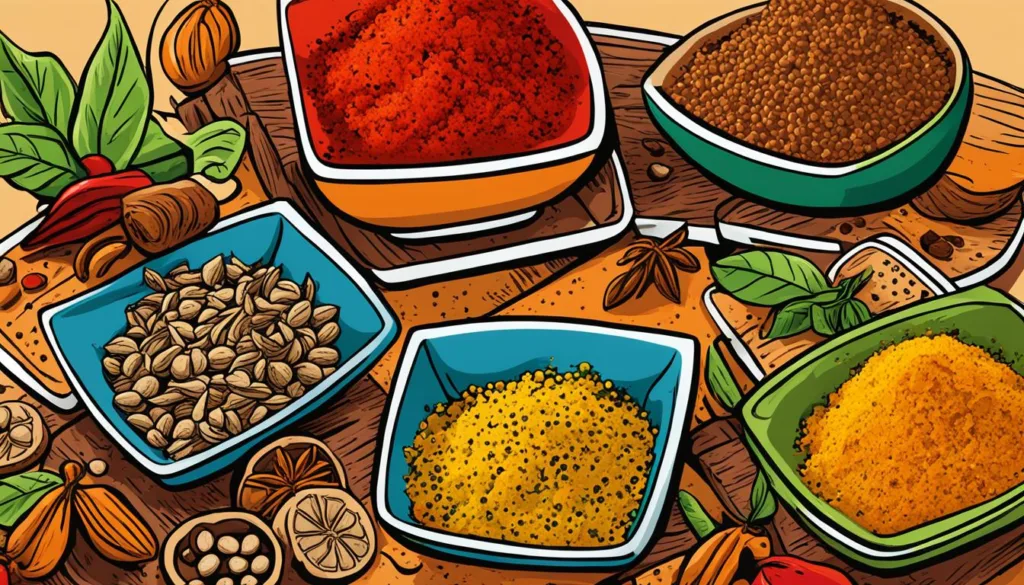
Spotlight on Traditional Ghanaian Cooking Methodology
The essence of Ghanaian culinary traditions is deeply rooted in techniques passed down through generations. To truly appreciate Ghanaian cooking techniques, one must delve into the processes that make these traditional Ghanaian recipes so distinct and flavorful. In Ghana, cooking is an art that combines flavor with cultural significance, creating a language of its own that is spoken in the aromas and tastes of the nation’s cherished dishes.
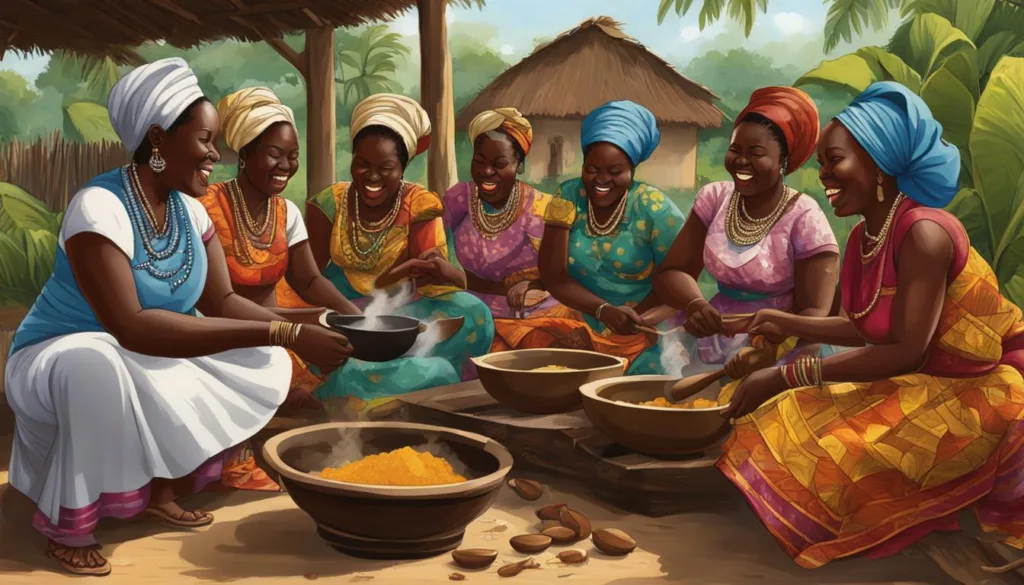
A vital component of Ghana’s culinary methodology is the practice of cooking over an open fire. This technique, especially prevalent in the preparation of grilled tilapia, not only cooks the food but infuses it with a smoky essence that cannot be replicated with modern stoves. Grilling methods showcase the natural flavors of the fish, highlighting the freshness and quality that are hallmarks of Ghanaian cuisine.
Meanwhile, the traditional dishes of fufu and banku involve a labor-intensive process of pounding, which is emblematic of the dedication to craft and the communal nature of Ghanaian culinary traditions. Shared amongst family members, the preparation of these dishes is as much a social activity as it is a culinary one, with the rhythmic pounding serving as an echo of heritage and togetherness.
- Fermentation process for kenkey – accentuating the deep flavors inherent to the grains
- Use of local herbs in Tuo Zaafi’s soup – enriching the dish with a profile of indigenous flavors
These practices are not only preserved for their taste but also for their cultural significance. They serve as a bridge from the past to the present, bringing the essence of Ghanaian cooking techniques into modern kitchens while preserving the integrity of their flavors.
“The hands that prepare Ghana’s meals carry the stories of our ancestors, weaving a tale of nourishment and heritage into every bite.”
In conclusion, the legacy of traditional dishes in Ghana relies heavily on the methods by which they are prepared. Through these time-honored techniques, the nation’s Ghanaian culinary traditions are preserved, ensuring that they remain an integral part of Ghana’s cultural identity, cherished by those who prepare them and revered by those who savour them.
The Colors and Textures of Ghanaian Street Food
The bustling streets of Ghana offer a canvas where the rich tapestry of Ghanaian street food is painted with the vivid colors and inviting textures of traditional Ghanaian dishes. From sizzling kebabs to sumptuous waakye, the range of street-side delicacies is a testament to the dynamic Ghanaian food culture engulfing both natives and visitors alike.
- Kenkey: Fermented corn dough served with spicy pepper sauce and fish.
- Kelewele: Sweet ripe plantains cut into chunks, spiced with ginger and chili, and deep-fried to golden perfection.
- Chichinga: Succulent kebabs marinated in local spices and grilled over an open flame.
- Waakye: Rice and beans cooked together, often served with a variety of rich, flavorful accompaniments.
Stepping into this culinary mosaic, one witnesses a symphony of flavors melding the reverence for age-old customs with contemporary flair. Here, the food is not just nourishment, but a narrative of community, craftsmanship, and innovation.
| Dish | Main Ingredients | Taste Profile | Common Accompaniments |
|---|---|---|---|
| Kenkey | Fermented corn dough | Tangy and robust | Grilled fish, pepper sauce, fried shrimp |
| Kelewele | Ripe plantains, ginger, chili | Spicy and sweet | Roasted peanuts, black-eyed peas |
| Chichinga | Meat or vegetables, local spices | Savory and smoky | Raw vegetables, spicy dipping sauce |
| Waakye | Rice, beans | Earthy and hearty | Boiled eggs, stew, salad |
Each portion of Ghanaian street food is more than a dish; it’s an invitation to explore the heart and soul of Ghana through its culinary delights. These flavors that traverse the streets bridge historical practices and modern gastronomy, creating experiences that are as rich in culture as they are in taste.
Ghana’s Culinary Regions: From Coast to Savannah
Exploring the traditional Ghanaian dishes and regional Ghanaian recipes reveals how deeply Ghana’s culinary geography influences its food culture. The rich array of flavors that characterize Ghana’s different areas is a reflection of the local resources and practices – from the bountiful coastline to the expansive savannah.
Seafood Delicacies of the Coastal Towns
The coastal towns of Ghana are known for their seafood specials that utilize the fresh catches of the day. Grilled tilapia, seasoned with local spices, exemplifies the kind of traditional Ghanaian dishes that reflect the community’s connection with the Atlantic Ocean. These dishes aren’t merely sustenance; they represent a way of life for the people who rely on the sea.
Savory Treasures of the Savannah: Dishes Shaped by Geography
In the savannah, the culinary focus shifts towards grains and hearty meats. One such dish is Tuo Zaafi, a filling and nutritious meal common to the northern regions of Ghana. It encapsulates how geography plays a significant role in shaping not just the dietary but also the cultural fabric of regional Ghanaian recipes.
Regional Spices that Elevate Ghanaian Cooking
The use of local spices like Scotch Bonnet peppers adds depth and heat to the cuisine, an essential feature of Ghanaian cooking. Such regional spices transform simple ingredients into complex and flavorful traditional Ghanaian dishes that speak volumes about the zest for life in Ghana’s diverse communities.
Where to Experience the Best of Ghanaian Culinary Delights
Embarking on a culinary journey to discover the best Ghanaian meals can be as simple as walking into one of the many authentic Ghanaian restaurants popping up in cities across the globe. Food enthusiasts will find themselves delighted by the rich flavors of traditional dishes, prepared with love and an appreciation for the cultural heritage they represent.
Authentic Ghanaian Restaurants Worth a Visit
If you’re seeking to immerse yourself in Ghana’s epicurean culture, these eateries provide an authentic dining experience. Renowned for their commitment to traditional cooking methods, these restaurants deliver a dining adventure akin to a trip through the heart of Ghana.
Sampling Street Food: A Gastronomic Adventure
The true essence of Ghanaian gastronomy pulses in the vibrant street food scene. From the sizzle of kelewele to the comforting bowl of waakye, the street stalls are a testament to the country’s love affair with hearty, flavorful food.
International Spots for Authentic Ghanaian Cuisine
As international Ghanaian cuisine earns its place in the global culinary sphere, food lovers no longer need to travel far to enjoy these distinctive flavors. In major cities around the world, chefs are bringing the taste of Ghana to an international audience, showcasing dishes brimming with tradition and innovation.
To aid your exploration, here is a table highlighting some incredible places where one can savor authentic Ghanaian cuisine:
| Location | Notable Ghanaian Dish | Cultural Experience |
|---|---|---|
| Accra | Jollof Rice | Heart of Ghanaian Festivities |
| Kumasi | Fufu and Goat Light Soup | Soul of Ashanti Cooking |
| Tamale | Tuo Zaafi | Taste of the North |
| New York | Kelewele | Street Food with a Twist |
| London | Banku and Tilapia | River Fish Delicacy |
Conclusion
Embarking on a gastronomic exploration through the rich food culture of Ghana reveals a vibrant tableau of regional specialties and foundational ingredients that define this nation’s cuisine. From the revered Jollof Rice, with its deep history and border-transcending love, to the street-side favorite waakye, each recipe not only satisfies the palate but also offers a foray into the customs and communal spirit deeply rooted in Ghanaian society. Discovering these dishes, whether amidst the bustling avenues of Accra, within the warm envelopment of local restaurants, or at international venues celebrating Ghana’s culinary exports, promises a multifaceted sensory journey.
This Ghanaian culinary guide serves as a compass to a world where each meal tells a story and each spice unwraps an anecdote, inviting avid food enthusiasts and curious novices alike to delve into the rich tapestry of Ghanaian flavors. It steers explorers through an authentic dining experience that’s as diverse as the landscapes from which it hails. Savoring the nation’s fare is not just about eating; it’s about connecting with a history that’s as flavorful as the food itself.
As the culinary narrative of Ghana continues to unfold, it carries along an enduring legacy of taste innovation blended with a steadfast preservation of tradition. The enduring quest for exploring Ghanaian flavors affirms the place of Ghanaian cuisine as not merely a series of regional dishes but as an evolving story—one that invites the world to partake in its heartfelt and enthusiastic celebration. Truly, the culinary guide to Ghana’s edible delights is a testament to a culture that takes great pride in its cuisine—a journey that’s as enriching as it is delicious.
FAQ
What are some traditional Ghanaian dishes I should try?
You should definitely try Jollof Rice, Banku and Tilapia, Waakye, Fufu with a light soup, and Kelewele. Each dish offers a unique taste and represents the rich food culture of Ghana.
How has history and culture influenced Ghanaian cuisine?
Ghana’s rich history and diverse culture have deeply influenced its food. The various ethnic groups within Ghana and interactions with other cultures throughout history have contributed to the development of a unique culinary landscape, with each group bringing their flavors and cooking techniques to the table.
Can you tell me more about traditional Ghanaian cooking methods?
Traditional cooking methods in Ghana include the use of clay pots and open flames, which infuse dishes with a smoky flavor. Grinding and pounding ingredients are common, especially for making pastes and doughs like those used in Fufu and Banku.
Which local ingredients are pivotal to Ghanaian recipes?
Staples like plantains, groundnuts (peanuts), and palm nut oil are central to Ghanaian dishes. Plantains are used in both sweet and savory dishes; groundnuts add a rich, nutty flavor to stews and soups; and palm nut oil is known for its reddish color and distinctive flavor.
Are there any specific Ghanaian spices I should know about?
Yes, common spices include ginger, Scotch Bonnet peppers, and anise. These spices are used in various combinations to create the distinctive flavor profiles of Ghanaian cuisine.
What is Jollof Rice, and why is it significant?
Jollof Rice is a beloved one-pot rice dish cooked with tomatoes, onions, and spices. It’s significant because it is a festive dish often served at celebrations and is a symbol of regional pride, with different countries in West Africa having their specific variations.
What is the culinary significance of Waakye?
Waakye is a traditional dish made from rice and beans, commonly served with a variety of accompaniments like stew, fried plantains, and salad. It’s a significant dish because it originated in Northern Ghana and has become a staple throughout the country, often eaten for breakfast or lunch.
How can I experience authentic Ghanaian cuisine?
Authentic Ghanaian cuisine can be experienced by visiting Ghana and trying the dishes at local eateries, street food stalls, and markets. Alternatively, you can visit Ghanaian restaurants in different parts of the world and festivals or events featuring international cuisine.
What role do geography and regional ingredients play in Ghanaian cooking?
Geography greatly influences the availability of ingredients and the types of dishes that are popular in various regions. Coastal areas use more fish and seafood, while inland regions use ingredients like yams and grains. Regional ingredients and spices add distinct flavors unique to each area’s culinary identity.
Are there any modern twists on traditional Ghanaian meals?
Yes, chefs in Ghana and around the world are putting contemporary spins on traditional meals, incorporating new ingredients and techniques while still honoring the essence of the original dishes. This has led to a dynamic culinary scene that respects tradition but also embraces innovation.
